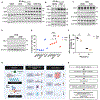Inhibition of LSD1 with Bomedemstat Sensitizes Small Cell Lung Cancer to Immune Checkpoint Blockade and T-Cell Killing
- PMID: 35920742
- PMCID: PMC9844673
- DOI: 10.1158/1078-0432.CCR-22-1128
Inhibition of LSD1 with Bomedemstat Sensitizes Small Cell Lung Cancer to Immune Checkpoint Blockade and T-Cell Killing
Abstract
Purpose: The addition of immune checkpoint blockade (ICB) to platinum/etoposide chemotherapy changed the standard of care for small cell lung cancer (SCLC) treatment. However, ICB addition only modestly improved clinical outcomes, likely reflecting the high prevalence of an immunologically "cold" tumor microenvironment in SCLC, despite high mutational burden. Nevertheless, some patients clearly benefit from ICB and recent reports have associated clinical responses to ICB in SCLC with (i) decreased neuroendocrine characteristics and (ii) activation of NOTCH signaling. We previously showed that inhibition of the lysine-specific demethylase 1a (LSD1) demethylase activates NOTCH and suppresses neuroendocrine features of SCLC, leading us to investigate whether LSD1 inhibition would enhance the response to PD-1 inhibition in SCLC.
Experimental design: We employed a syngeneic immunocompetent model of SCLC, derived from a genetically engineered mouse model harboring Rb1/Trp53 inactivation, to investigate combining the LSD1 inhibitor bomedemstat with anti-PD-1 therapy. In vivo experiments were complemented by cell-based studies in murine and human models.
Results: Bomedemstat potentiated responses to PD-1 inhibition in a syngeneic model of SCLC, resulting in increased CD8+ T-cell infiltration and strong tumor growth inhibition. Bomedemstat increased MHC class I expression in mouse SCLC tumor cells in vivo and augmented MHC-I induction by IFNγ and increased killing by tumor-specific T cells in cell culture.
Conclusions: LSD1 inhibition increased MHC-I expression and enhanced responses to PD-1 inhibition in vivo, supporting a new clinical trial to combine bomedemstat with standard-of-care PD-1 axis inhibition in SCLC.
©2022 American Association for Cancer Research.
Figures





Comment in
-
LSD1-targeted therapy-a multi-purpose key to unlock immunotherapy in small cell lung cancer.Transl Lung Cancer Res. 2023 Jun 30;12(6):1350-1354. doi: 10.21037/tlcr-23-40. Epub 2023 Mar 30. Transl Lung Cancer Res. 2023. PMID: 37425423 Free PMC article. No abstract available.
References
-
- Paz-Ares L, Dvorkin M, Chen Y, Reinmuth N, Hotta K, Trukhin D, et al. Durvalumab plus platinum-etoposide versus platinum-etoposide in first-line treatment of extensive-stage small-cell lung cancer (CASPIAN): a randomised, controlled, open-label, phase 3 trial. Lancet 2019;394(10212):1929–39 doi 10.1016/S0140-6736(19)32222-6. - DOI - PubMed
-
- Funa K, Gazdar AF, Minna JD, Linnoila RI. Paucity of beta 2-microglobulin expression on small cell lung cancer, bronchial carcinoids and certain other neuroendocrine tumors. Lab Invest 1986;55(2):186–93. - PubMed
Publication types
MeSH terms
Substances
Grants and funding
LinkOut - more resources
Full Text Sources
Medical
Molecular Biology Databases
Research Materials
Miscellaneous

